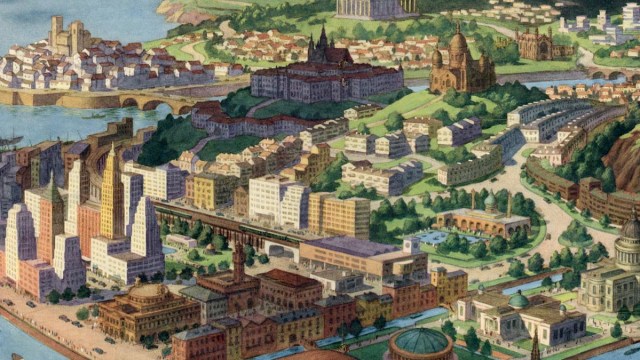Sign up for Big Think on Substack
The most surprising and impactful new stories delivered to your inbox every week, for free.

North America must have the lowest nation/surface ratio in the world. The huge subcontinent is made up of only two sovereign states: Canada and the US (*). This is not to say that this was a ‘Manifest Destiny’: many regionalist revolts were crushed to form these two monoliths.
Which raises the question, at least in Matthew White’s mind: “What is the most fragmented that North America could have been?” White’s website (from the mid-nineties, but still online) serves up several ‘alternate history’ maps, that use a POD (point of divergence) somewhere in the past to construct a present slightly (or wildly) different from ours. White’s Balkanised North America, with 1787 as the POD, is by far the most interesting exercise.
“In this alternate reality, the westward expansion of the Anglo-American people proceeded pretty much as it did in our reality,” White writes, “but the United States government just couldn’t keep up. Every national identity crisis resolved itself in favor of the separatists instead.”
On the map, White details as sovereign, areas that: “1. administered themselves as autonomous nations at some point in American history, or 2. shed blood to achieve or maintain their independence, or at least 3. threatened to.”
One important caveat: “The Native American tribes throughout the continent fit all these criteria, but I limited myself to only three native enclaves.”
In 1787, a fire in the Philadelphia State House kills George Washington, Benjamin Franklin, James Madison and other members of the Constitutional Convention. This leads to a radically different constitution, and a fundamentally weaker Union.Vermont was an independent state until it joined the US as its fourteenth state in 1791. Not in White’s timeline: “Annoyed at the way the new federal government under John Adams is shaping up, Vermont refuses to join the Union, declaring itself an independent republic instead.”President Aaron Burr (in reality he was only vice-president at the time, if only by a hair’s breadth) annoys the French so much that Napoleon refuses to sell the gigantic Louisiana Territory to the US.In 1812, following an unsuccessful US invasion of Canada, New England secedes. Napoleon does sell Upper Louisiana to the US, but retains the densely populated area around Nouvelle Orléans.French Louisiana declares itself independent in 1815, refusing to recognize the Bourbon dynasty reinstated after Napoleon’s Waterloo defeat.Indian tribes east of the Mississippi are expelled to what later will become the Five Nations area (our Oklahoma, more or less).In 1835, Louisiana supports Texas independence from Mexico on condition that the new republic not join the US.Seminole Indians in Florida, together with runaway slaves, drive out the invading US in 1837.The Mormons found the theocratic state of Deseret within Mexican territory. Upper Canada and Quebec rebel from Great Britain and achieve independence in 1837-’41.The slave vs. free state quarrel, playing out more in favour of the South in this timeline, prevents an accession of settlers in Oregon to the US. They declare independence instead, in 1846.The Californian Gold Rush still happens as it did in our timeline, but it causes California and Deseret to claim independence from Mexico (in 1852) and Texas to push its border south to the Rio Grande. Mexico only manages to retain part of ‘our’ Arizona and New Mexico.Abe Lincoln elected president. The South secedes. The North, lacking the industrial muscle of New England, cannot subdue the South. The Five Nations take advantage by declaring independence.Canadian mismanagement of relations with the métis (a people made up of French and native components) in 1870-’72 leads to a successful revolt along the Red River, establishing a Métis Nation.Custer’s command is wiped out at Little Bighorn in 1876, leading to the establishment of the Dakota Nation.Not mentioned in this timeline, but present on the map: the Maritime Dominion, a British toehold on the North American subcontinent (New Brunswick and Nova Scotia); and Newfoundland, either a separate British dominion or an independent state. Depending on the latter, this ‘balkanised’ North America is composed of no less than 17, and possibly 18 territories with different sovereignties. Compared with the real-time country that stretches ‘from sea to shining sea’, this USA has been reduced to a rump state – somewhat reminiscent of present-day Serbia relative to former Yugoslavia.
(*): Please note that the definition of ‘North America’ varies: in Anglo-America (i.e. English-speaking Canada and the US) it is often held to be synonymous with the US and Canada. Sometimes, Mexico is included. And/or St Pierre and Miquelon (a French-administered collectivité territoriale off Canada’s Atlantic coast). And/or Bermuda. All of which would take the number of sovereign states covering North America up to five – still a very small number.
This map was sent in by Kári Tulinius, Matthew White’s website can be found here.
Sign up for Big Think on Substack
The most surprising and impactful new stories delivered to your inbox every week, for free.






